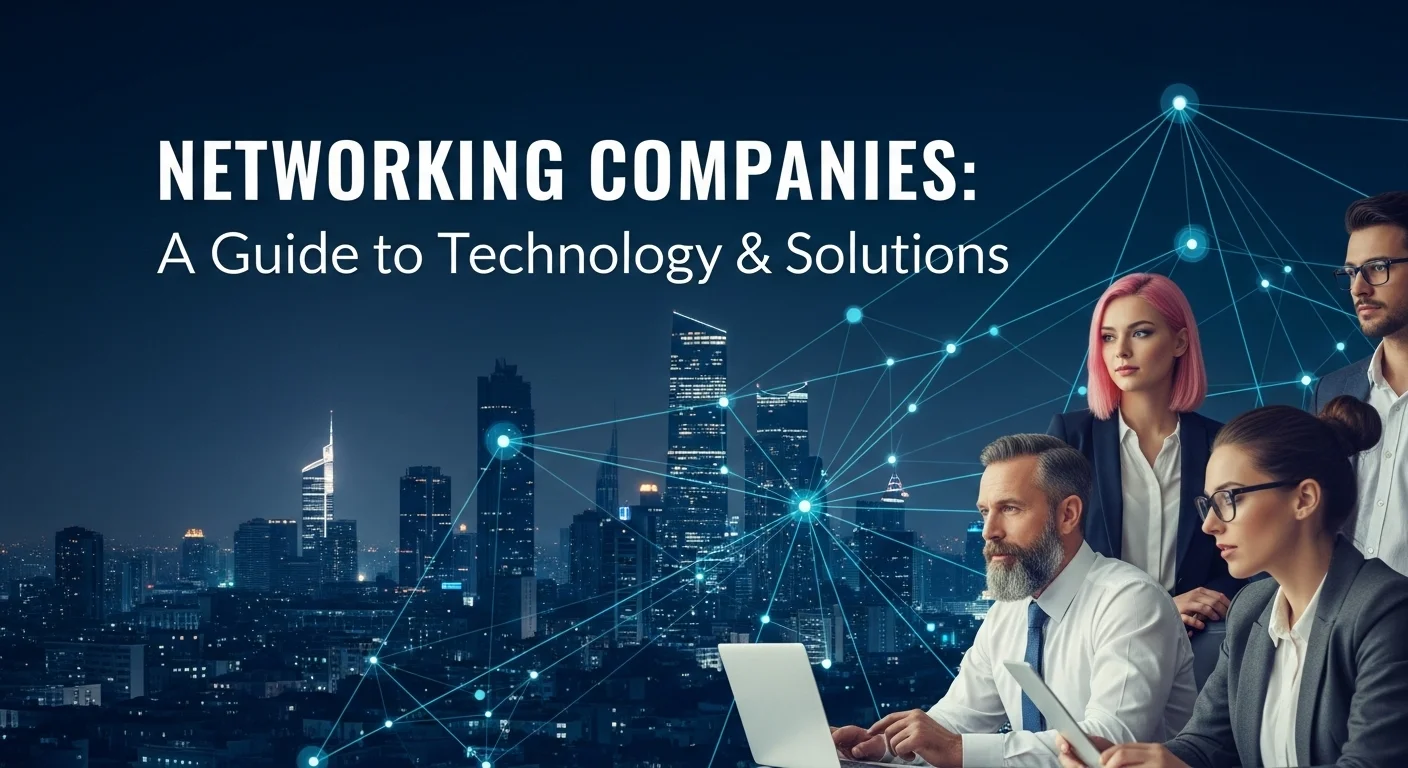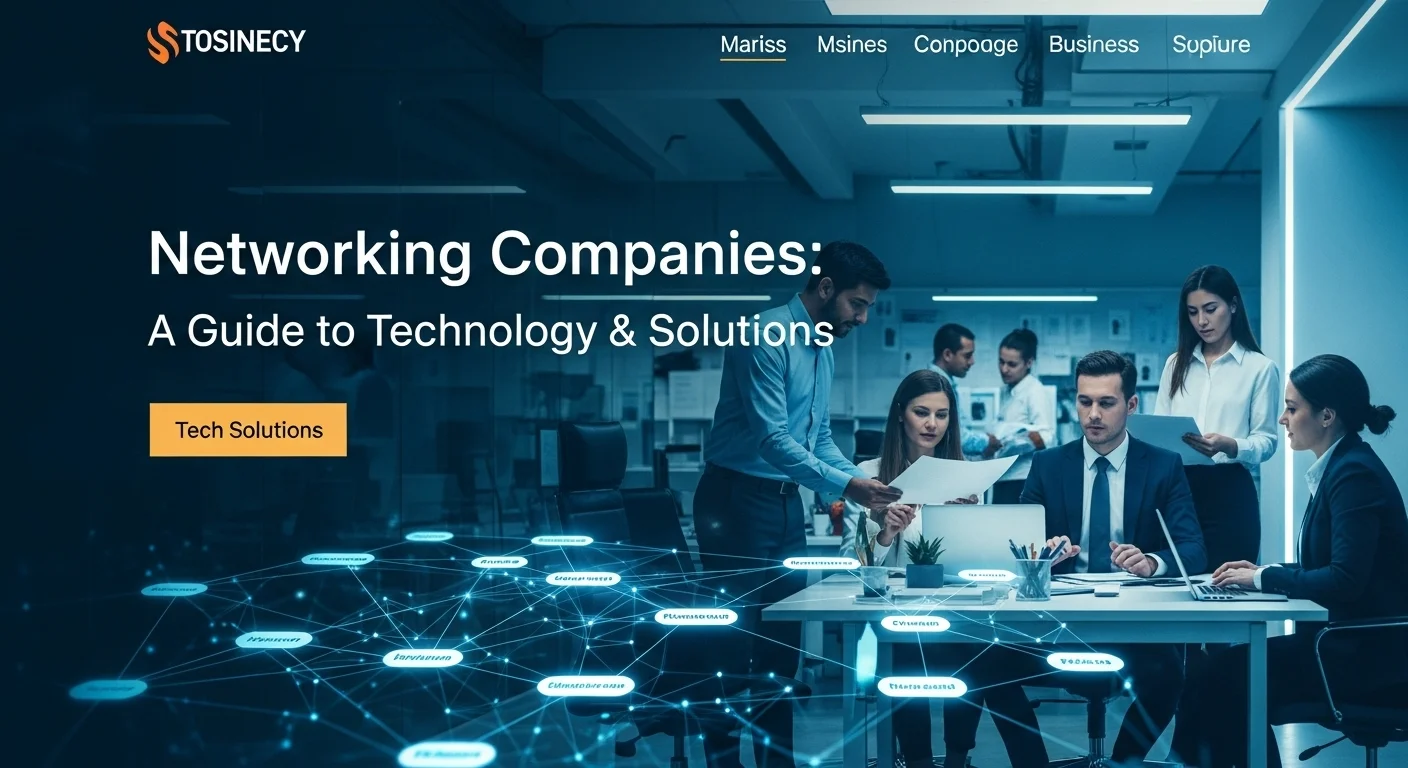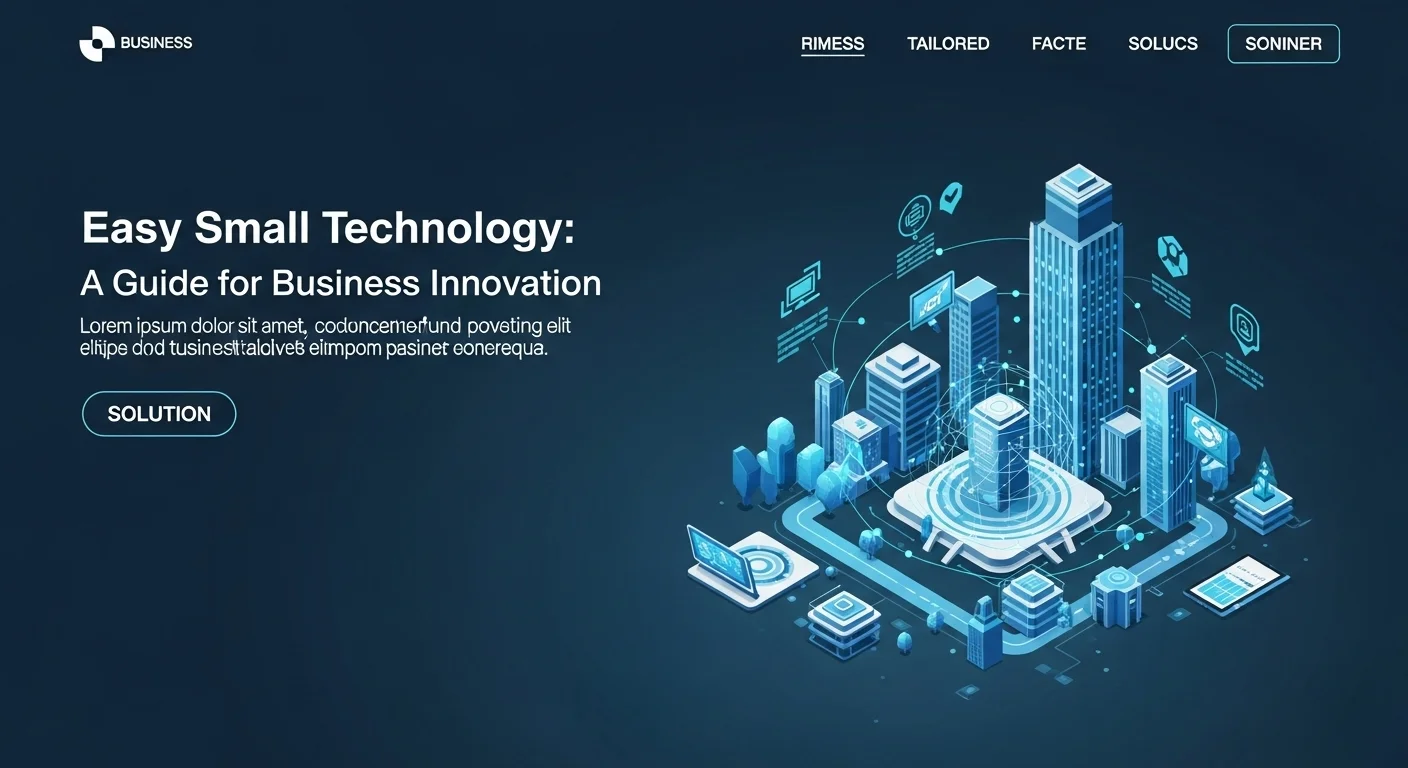Choosing Your Networking Partner: A Real-World Guide to Tech, Security & Cloud

Executive Summary
I've spent over 15 years in IT infrastructure, and I’ve seen countless businesses make the same costly mistake: they treat their network as an afterthought. It's the invisible foundation of everything they do, and when it cracks, the whole business feels it. Networking companies are the ones who lay that foundation—from the hardware giants like Cisco that build the digital highways, to the specialized security firms that act as your digital bodyguards, and the cloud providers like AWS and Azure that offer futuristic infrastructure on demand. This article is my attempt to demystify this world. We'll break down what these companies actually do, explore the crucial differences between them, and walk through the real-world technologies that can either hold your business back or propel it forward. My goal is to give you the confidence to choose the right partner and build a network that's not just functional, but a genuine competitive advantage.
Table of Contents
What are Networking Companies and why are they so crucial?
Let's be honest, the term 'networking company' can sound pretty abstract. In my experience, it's easier to think of it like this: if your business is a building, these companies provide the electricity, the plumbing, and the security system that makes everything work. They build and maintain the pathways that your data travels on. Every email you send, every video call you join, every piece of customer data you access from the cloud—it all relies on the hardware and software created by a networking company. Without them, the digital world as we know it would grind to a halt. We're talking about a massive industry, worth hundreds of billions, because it is the fundamental bedrock of modern business and communication.
Understanding the Different Players in the Game
For years, the field has been shaped by titans of the industry. When I started my career, if you needed a router or a switch, you almost always turned to Cisco. They are still a dominant force, providing the foundational hardware that powers a huge chunk of the internet and corporate networks. But the landscape is much richer now. You have other major players like Juniper Networks, Arista, and HPE, all building powerful, reliable gear. It's not a one-size-fits-all market anymore. It's a diverse ecosystem, and that's where things get interesting and where you have to start making smart choices. You see, the company that sells you a switch isn't necessarily the same one you'd trust to protect your entire network from a sophisticated cyberattack.
The Rise of Specialized Protectors: Network Security
This brings us to a critical distinction: network security companies. As our reliance on digital systems grew, so did the threats. I've seen firsthand how a data breach can devastate a business. That's why a new breed of company emerged, focusing solely on defense. Think of it this way: a company like Cisco might build the highway, but a company like Palo Alto Networks, Fortinet, or Check Point provides the armored cars, the surveillance cameras, and the security checkpoints. They offer what we call a network security solution, which is a whole suite of tools—firewalls, VPNs, threat detection systems—designed to work together to keep the bad guys out. Choosing from the top network security companies has become one of the most important decisions a CIO or business owner can make, because a weak defense puts everything at risk.
Moving to the Cloud: A New Networking Paradigm
Then, about a decade ago, the cloud changed everything. Businesses began shifting from running their own servers in a back room to renting infrastructure from giants like Amazon Web Services (AWS), Microsoft Azure, and Google Cloud Platform (GCP). This created a whole new category: cloud networking companies. These providers let you build complex, global networks with a few clicks of a mouse instead of racks of physical hardware. You can create virtual private networks, balance traffic, and connect to your offices securely, all managed through a web browser. I remember the first time I deployed a multi-region network on AWS in an afternoon; it was a task that would have taken months and a huge budget just a few years prior. This shift has forced everyone to adapt, blending traditional on-premise networks with the incredible flexibility the cloud offers.
The Real-World Impact on Your Business
So, why does all this matter? Because a well-designed network, built with the right partners, has a direct impact on your bottom line. It means your employees can collaborate without frustrating lag, your applications run smoothly, and your customers have a seamless experience. For an e-commerce site, a fraction of a second in page load time can mean the difference between a sale and a lost customer. More importantly, a secure network, protected by one of the best network security companies, defends your reputation, your intellectual property, and your customers' trust. As we look ahead to trends like AI managing networks and the explosion of Internet of Things (IoT) devices, the role of these companies will only become more vital. They are, quite simply, the enablers of our digital future.

Your Complete Guide to Networking Tech and Business Solutions
Alright, let's get practical. When you start talking to vendors, you're going to be hit with a flood of acronyms and technical specs. My goal here is to give you a mental map to navigate this landscape, comparing the different technologies so you can make decisions that actually solve your business problems.
The Nuts and Bolts: What Are You Actually Buying?
At its heart, a network is built from a few key pieces of hardware. I've deployed thousands of these devices over the years, and here's the simple breakdown:
- Routers: Think of a router as the post office sorting center for your data. It sits between different networks (like your office and the internet) and figures out the best path to send your information. Enterprise-grade routers are workhorses, built to handle huge volumes of traffic and prioritize the important stuff, like a video conference call over a large file download.
- Switches: If the router is the sorting center, the switch is the local mail carrier for your office building. It connects all the devices *within* a single network—your computer, your printer, your desk phone—and makes sure data packets get to the right desk, so to speak.
- Firewalls: This is your network's security guard. A modern firewall from a top network security company like Fortinet or Palo Alto Networks isn't just a simple gatekeeper; it's more like an intelligent security checkpoint that inspects the contents of the traffic, understands which applications are being used, and can spot suspicious behavior.
- Wireless Access Points (WAPs): This is how you get Wi-Fi. We've all experienced bad Wi-Fi, and it's incredibly frustrating. Modern WAPs are designed to handle crowded spaces and data-hungry applications, ensuring a smooth wireless experience.
The 'brain' behind this hardware is the software. We're moving away from configuring each box individually towards centralized platforms that give you a bird's-eye view of your entire network, which is a huge time-saver.
The Game Changer: SD-WAN
Software-Defined Networking (SDN) was a huge conceptual shift, but its most practical application for most businesses is SD-WAN. In the old days, connecting offices meant buying expensive, private data lines. It was reliable but rigid and costly. SD-WAN is like a smart GPS for your network traffic. It lets you use a mix of connections—broadband internet, 5G, whatever is available—and intelligently routes your application traffic over the best path at any given moment. I've helped clients cut their connectivity costs by over 50% by switching to SD-WAN, while actually improving performance for their cloud apps.
The New Frontier: Cloud Networking
Working with cloud networking companies like AWS and Azure feels like playing with digital LEGOs. They provide all the networking components you need as on-demand services:
- Virtual Private Cloud (VPC): This is your own private, fenced-off section of the public cloud. It's a virtual network that you control completely, where you can launch your servers and databases securely.
- Cloud Load Balancers: If you have a popular website, a load balancer is essential. It distributes incoming traffic across multiple servers so no single one gets overwhelmed, keeping your application fast and available.
- Direct Connect/ExpressRoute: This is a private, high-speed fiber optic cable from your office directly to the cloud provider. It's for when you need a super stable and fast connection, bypassing the public internet entirely.
The real challenge I see today is managing this 'hybrid' world—partly in the cloud, partly on-premise. This has led to new solutions that create a seamless networking fabric across all your environments.
A Deep Dive into Network Security
Your network is bigger than ever, with users at home, in the office, and on the road. This means your attack surface is bigger, too. A modern network security solutions company focuses on a few key principles:
- Zero Trust Architecture: I tell every client this: the old model of a 'trusted' internal network is dead. Zero Trust operates on a simple, powerful motto: 'never trust, always verify.' It means every single request to access data is challenged and authenticated, whether it comes from inside or outside the office. It's like having a security guard at every single door in your building, not just the front entrance.
- SASE (Secure Access Service Edge): It's a mouthful, but the concept is brilliant. SASE combines your networking (like SD-WAN) and your security (like firewalls and web gateways) into a single service delivered from the cloud. For a company with a lot of remote workers, this is a game-changer. It means your employees get fast, secure access to applications no matter where they are, without having to route all their traffic back through a central office.
- XDR (Extended Detection and Response): This is about seeing the whole picture. Instead of just looking at alerts from your firewall or your laptops, XDR platforms pull in data from everywhere—network, cloud, email, endpoints—and use AI to connect the dots and spot sophisticated attacks that might otherwise be missed.
Making the Right Choice: My Personal Checklist
When I advise a business, I tell them to think about these things:
- Platform vs. Best-of-Breed: Do you want the simplicity of an all-in-one platform from a single vendor, or do you want to pick the absolute best tool for each specific job? The first is easier to manage; the second offers more power but can be more complex. There's no single right answer, it depends on your team's expertise.
- Can it Grow with You?: Don't just buy for today. Will this solution handle double the users? Triple the traffic? Ask the hard questions about scalability.
- Is it Easy to Manage?: A powerful tool that no one on your team knows how to use is worthless. A good management interface and automation capabilities can save you hundreds of hours in labor.
- Look at the Total Cost: Don't be fooled by a low upfront price. Factor in subscriptions, support contracts, and the staff time needed to run it.
Ultimately, whether you're working with hardware giants, specialized network security solutions companies, or agile cloud networking companies, the goal is the same: to build a network that is a silent, reliable, and secure engine for your business's growth.

Your Playbook: Making Smart Choices and Future-Proofing Your Network
In my line of work, I see a lot of 'buyer's remorse.' It usually comes from choosing a technology partner based on a flashy demo or a low price tag without a real strategy. To avoid that, you need a playbook. Here are the tips and strategies I share with my clients to make sure their network becomes a genuine asset.
Best Practices for Choosing Your Partners
This is the most important part of the process. Getting this right saves you headaches for years to come. Here’s my step-by-step guide:
Step 1: Know Thyself (and Your Network Needs): Before you even talk to a sales rep, do an internal audit. What do you absolutely depend on? Is it your CRM? Your VoIP phone system? What are your biggest pain points right now? Slowness? Unreliability? Security worries? What regulations (like HIPAA or PCI DSS) do you have to follow? Write it all down. This document is your north star.
Step 2: See the Whole Board: Don't get tunnel vision. You might think you just need a new firewall, but that firewall needs to work with your cloud setup and your remote users. So, you need to evaluate hardware vendors, network security companies, and cloud networking companies together. I always ask: 'How will these different systems talk to each other?' A great security tool that doesn't integrate with your cloud environment is a missed opportunity.
Step 3: Don't Just Read the Brochure—Demand a PoC: I cannot stress this enough. A Proof of Concept (PoC) is where you test-drive a solution in your own environment. Sales presentations are designed to look perfect. A PoC will show you the reality. How easy is it to actually set up? Does it slow anything down? For a security solution, a PoC is critical for seeing how many false alarms it generates. Never buy anything significant without a successful PoC.
Step 4: Think in Platforms, Not Products: The days of buying a dozen different, disconnected security tools are over. It's too complex and leaves dangerous gaps. Look for vendors who offer an integrated platform, like a SASE or XDR architecture. When you research the top network security companies, look at how well their products work together to automate threat responses. This is the key to creating a security posture that's proactive, not just reactive.
Step 5: Judge Them by Their Brains (Threat Intelligence): A security product is only as smart as the threat intelligence feeding it. The best network security companies have world-class research teams (like Cisco's Talos or Fortinet's FortiGuard Labs) working around the clock to find the next big threat before it hits you. I always ask potential vendors about their research team and how quickly they can protect me from a new, zero-day vulnerability.
Step 6: Ask About the Future—AI and Automation: The only way to manage the complexity of modern networks is with AI and automation. The buzzword is AIOps (AI for IT Operations). It means using AI to predict problems before they happen and automate troubleshooting. When you pick a partner, you're not just buying their current tech; you're investing in their vision. Ask to see their AI roadmap.
Tools and Experiences to Maximize Your Investment
Once you've made a choice, the work isn't over. You have to get the most out of your investment.
- Master the Dashboard: Your new system will come with a centralized management console. This is your command center. Invest the time to train your team on it. It’s the key to visibility and control.
- Get Your Team Certified: Vendors like Cisco and Fortinet have excellent certification programs. Sending your IT staff to get certified is an investment that pays for itself. They'll learn best practices and be far more efficient at managing the technology.
- Don't Work in a Silo: There are vibrant online communities for almost every major vendor. These forums are amazing for finding answers to weird problems and learning from how others have solved similar challenges.
- Consider a Managed Service: If you're a smaller business without a large IT team, a Managed Security Service Provider (MSSP) can be a lifesaver. They can manage your network security for you, giving you access to expertise you couldn't afford to hire in-house.
Staying Ahead: Trends I'm Watching Closely
The tech world never stands still. Here’s what I’m telling my clients to prepare for:
- The SASE Takeover: This isn't a fad. The convergence of networking and security into a single cloud service is the future for any business with a distributed workforce.
- AI Everywhere: AI will become the co-pilot for every network administrator. It will find threats humans would miss and solve problems before anyone even notices them.
- Network as a Service (NaaS): Think of it like Netflix for your network. Instead of buying hardware, you'll subscribe to networking capabilities as a service. This shifts your spending from large capital expenses to predictable operating expenses and offers incredible flexibility.
- The IoT and Edge Explosion: We're connecting more 'things' to the internet than ever before. This is creating a new 'edge' to the network that needs to be managed and secured in a completely new way.
By taking a strategic approach and staying informed, you can turn your network from a necessary evil into a powerful engine for your business's growth.
Expert Reviews & Testimonials
Sarah Johnson, Business Owner ⭐⭐⭐
The information about Networking Companies is correct but I think they could add more practical examples for business owners like us.
Mike Chen, IT Consultant ⭐⭐⭐⭐
Useful article about Networking Companies. It helped me better understand the topic, although some concepts could be explained more simply.
Emma Davis, Tech Expert ⭐⭐⭐⭐⭐
Excellent article! Very comprehensive on Networking Companies. It helped me a lot for my specialization and I understood everything perfectly.



